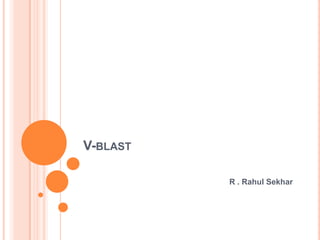
Vblast
- 1. V-BLAST R . Rahul Sekhar
- 2. THE BIG QUESTION With limited power, scarce and highly precious bandwidth, how to increase the data rate?
- 3. BLAST ARCHITECTURE Rich-scattering wireless channel is capable of enormous theoretical capacities if the multipath is properly exploited. A novel method used for this is using BLAST architecture Three specific implementations of BLAST, depending on the type of coding employed: 1. Diagonal-BLAST (D-BLAST) 2. Vertical-BLAST (V-BLAST) 3. Turbo-BLAST
- 4. WHY BLAST? Unlike code division or other spread-spectrum multiple access techniques, the total channel bandwidth utilized in a BLAST system is only a small fraction in excess of the symbol rate. Unlike FDMA, each transmitted signal occupies the entire system bandwidth. Finally, unlike TDMA, the entire system bandwidth is used simultaneously by all of the transmitters all of the time. Taken together, these differences together are precisely what give BLAST the potential to realize higher spectral efficiencies than the multiple-access techniques. An essential feature of BLAST is that no explicit orthogonalization of the transmitted signals is imposed by the transmit structure at all. Instead, the propagation environment itself, is exploited to achieve the signal decorrelation necessary to separate the co-channel signals.
- 5. D-BLAST It utilizes multi-element antenna arrays at both transmitter and receiver Diagonally layered coding structure in which code blocks are dispersed across diagonals in space time In a Rayleigh scattering environment, this structure leads to theoretical rates which grow linearly with the number of antennas(~90% of Shannon capacity)
- 7. D BLAST
- 8. V-BLAST Difference from D-Blast? V-BLAST architecture is a simplified version of D-BLAST, that tries to reduce its computational complexity. The layering is horizontal, meaning that all the symbols of a certain stream are transmitted through the same antenna (one stream per antenna). It eliminates the space time wastage, but loses the transmit diversity, since each stream is “tied” to its antenna.
- 9. APPLICATIONS V-BLAST is an essential part of MIMO technology. As such it is an integral part of modern wireless communication standards such as IEEE 802.11n (Wi-Fi), 4G, 3GPP Long Term Evolution, WiMAX and HSPA+.
- 10. SYSTEM OVERVIEW A single data stream is demultiplexed into M sub streams. Each sub stream is then encoded into symbols and fed to its respective transmitter. Transmitters 1 − M operate co-channel at symbol rate 1/ T symbols/sec. Each transmitter is itself an ordinary QAM transmitter. The same constellation is used for each substream.
- 11. Receivers 1 − N are, individually, conventional QAM receivers. These receivers also operate co-channel, each receiving the signals radiated from all M transmit antennas. Flat fading is assumed. The matrix channel transfer function is HN×M, where hi j is the (complex) transfer function from transmitter j to receiver i, and M ≤ N.
- 13. V-BLAST DETECTION Let a = (a1 , a2 , . . . ,aM ) T denote the vector of transmit symbols. Then the corresponding received N vector is r1 = Ha + ν where ν is a noise vector. Each substream in turn is considered to be the desired signal, and the remainder are considered as "interferers".(Nulling) Nulling is performed by linearly weighting the received signals so as to satisfy some performance-related criterion, such as minimum mean-squared error (MMSE) or zero-forcing (ZF). Zero-forcing Nulling can be performed by choosing weight vectors wi , i = 1 , 2 , . . . , M, such that wi T(H) j = δi j where (H) j is the jth column of H, and δ is the Kronecker delta. Thus, the decision statistic for the ith sub stream is yi = wi T ri
- 14. project the received signal y onto the subspace orthogonal to the one spanned by h1, h2.......hnt
- 15. Superior performance is obtained if nonlinear techniques are used. Use symbol cancellation as well as linear nulling to perform detection. Interference from already-detected components of a is subtracted out from the received signal vector, resulting in modified received vector in which, effectively, fewer interferers are present.
- 16. 1. Order determination, in which the N, received substreams are to be detected, in accordance with the post detection signal-to-noise ratios of the individual sub streams. 2. Detection of the sub stream, starting with the largest signal-to- noise ratio. 3. Signal cancellation, wherein the effect of the detected sub stream is removed from subsequent sub streams. 4. Repetition of steps 1 through 3 until all the N, received sub streams have been individually detected
- 18. (V-BLAST) DECODING Initialization: Recursion: i 1 wki (Gi ) ki G1 H H 2 y ki wki ri k1 arg min (G1 ) j j ˆ a ki Q ( y ki ) ri 1 ri ˆ a ki ( H ) ki G H (H H H ) 1 H H Gi 1 H ki G (H H H 2 I) 1H H 2 ki 1 arg min (Gi 1 ) j j k1ki i i 1
- 20. REFERENCES V-BLAST: An Architecture for Realizing Very High Data Rates Over the Rich-Scattering Wireless Channel P. W. Wolniansky, G. J. Foschini, G. D. Golden, R. A. Valenzuela Modern wireless communication Simon Haykin , Michael Moher BLAST Architectures Eduardo Zacar´ıas B. Fundamentals of wireless communication David Tse , Pramod Performance Analysis of V-BLAST Detectors for the MIMO channel Fenghua Li